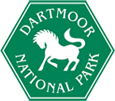Tors and Rocky Outcrops
The Dartmoor landscape is dominated by rocks, tors, clitter (boulders strewn across sloping ground, usually below tors), quarry faces and other rocky outcrops. These form important landscape and geological features as well as important wildlife habitats.
The rocks on Dartmoor are mainly granite and a typical tor has as many as 60 species of lichen covering much of the rock surface. Some rare ferns occur on rocks, as well as some stone walls, such as the nationally rare forked and lanceolate spleenworts, the beech fern and Wilson’s filmy fern.
Rocky outcrops are covered in mosses, lichens, and sometimes turf.
The nationally and internationally rare flax-leaved St John’s-wort can be found in its largest British population on the scree slopes of the upper Teign valley.
Birds closely associated with clitter slopes, tors and quarries are raven, peregrine falcon, wheatear and ring ouzel. Several pairs of ring ouzel breed around the tors of the north moor. Both ring ouzel and peregrine are rare.
Many rocky sites are designated as SSSIs purely for their geological interest and others fall within other larger SSSIs. Potential threats to these sites and their species include recreational activity, physical damage and disturbance to nesting birds by walkers and climbers, high stocking levels which damage the lichens and other plants through nutrient enrichment and acid rain.
